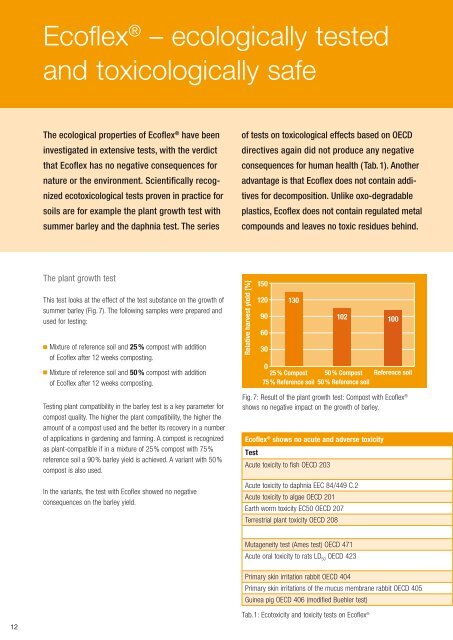Ecoflex Ecovio – Biopolymers – Inspired by nature – Broschüre
Ecoflex Ecovio – Biopolymers – Inspired by nature – Broschüre
Ecoflex Ecovio – Biopolymers – Inspired by nature – Broschüre
Create successful ePaper yourself
Turn your PDF publications into a flip-book with our unique Google optimized e-Paper software.
12<br />
<strong>Ecoflex</strong> ® <strong>–</strong> ecologically tested<br />
and toxicologically safe<br />
The ecological properties of <strong>Ecoflex</strong> ® have been<br />
investigated in extensive tests, with the verdict<br />
that <strong>Ecoflex</strong> has no negative consequences for<br />
<strong>nature</strong> or the environment. Scientifically recognized<br />
ecotoxicological tests proven in practice for<br />
soils are for example the plant growth test with<br />
summer barley and the daphnia test. The series<br />
The plant growth test<br />
This test looks at the effect of the test substance on the growth of<br />
summer barley ( Fig. 7). The following samples were prepared and<br />
used for testing:<br />
Mixture of reference soil and 25 % compost with addition<br />
of <strong>Ecoflex</strong> after 12 weeks composting.<br />
Mixture of reference soil and 50 % compost with addition<br />
of <strong>Ecoflex</strong> after 12 weeks composting.<br />
Testing plant compatibility in the barley test is a key parameter for<br />
compost quality. The higher the plant compatibility, the higher the<br />
amount of a compost used and the better its recovery in a number<br />
of applications in gardening and farming. A compost is recognized<br />
as plant-compatible if in a mixture of 25 % compost with 75 %<br />
reference soil a 90 % barley yield is achieved. A variant with 50 %<br />
compost is also used.<br />
In the variants, the test with <strong>Ecoflex</strong> showed no negative<br />
consequences on the barley yield.<br />
of tests on toxicological effects based on oECd<br />
directives again did not produce any negative<br />
consequences for human health ( Tab. 1). Another<br />
advantage is that <strong>Ecoflex</strong> does not contain additives<br />
for decomposition. Unlike oxodegradable<br />
plastics, <strong>Ecoflex</strong> does not contain regulated metal<br />
compounds and leaves no toxic residues behind.<br />
Relative harvest yield [%]<br />
Fig. 7: Result of the plant growth test: Compost with <strong>Ecoflex</strong> ®<br />
shows no negative impact on the growth of barley.<br />
<strong>Ecoflex</strong> ® shows no acute and adverse toxicity<br />
Test<br />
150<br />
120<br />
90<br />
60<br />
30<br />
130<br />
0<br />
25 % Compost 50 % Compost<br />
75 % Reference soil 50 % Reference soil<br />
Acute toxicity to fish OECD 203<br />
Acute toxicity to daphnia EEC 84 /449 C.2<br />
Acute toxicity to algae OECD 201<br />
Earth worm toxicity EC50 OECD 207<br />
Terrestrial plant toxicity OECD 208<br />
Mutageneity test (Ames test) OECD 471<br />
Acute oral toxicity to rats LD 50 OECD 423<br />
Primary skin irritation rabbit OECD 404<br />
Primary skin irritations of the mucus membrane rabbit OECD 405<br />
Guinea pig OECD 406 (modified Buehler test)<br />
102 100<br />
Tab. 1: Ecotoxicity and toxicity tests on <strong>Ecoflex</strong> ®<br />
Reference soil


